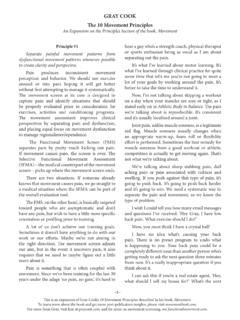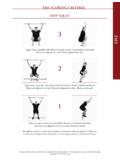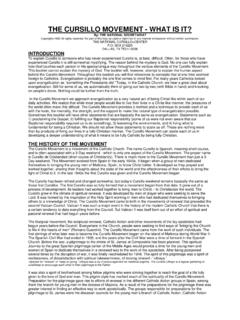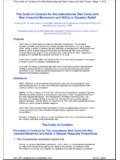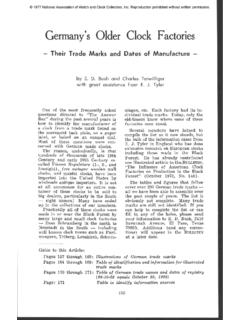Transcription of Mulligan’s Mobilization with Movement: A …
1 The Journal of Manual & ManipulaTive Therapy n voluMe 17 n nuMber 2 [e39]The treatment of musculoskeletal joint dysfunction may require a physiotherapist to use a number of modalities. Developed manual therapy techniques include that of Brian Mulli-gan s widely used Mobilization with movement (MWM) for peripheral joint pain1,2, also referred to as a mulligan mobilization3-5 or a manipulative tech - nique6, respect to the research, the clinical efficacy of mulligan s MWM techniques has been established for im-proving joint function, with a number of hypotheses for its cause and effect.
2 Mul-ligan s original theory for the effective-ness of an MWM is based on a mechani-cal model documented in his first teaching text8. This concept is related to minor positional faults that occur sec-ondary to injury and that lead to mal-tracking of the joint, resulting in symp-toms such as pain, stiffness, or weakness1. This theory in conjunction with the pre-scription of MWMs is still advocated in mulligan s latest edition and remains un-changed9. The cause of positional faults has been suggested as changes in the shape of articular surfaces, thickness of cartilage, orientation of fibers of liga-ments and capsules, or the direction and pull of muscles and tendons.
3 MWMs cor-rect this by repositioning the joint, caus-ing it to track normally1,10. Subsequent research to date also suggests that the mechanisms behind the effectiveness of MWMs are based on mechanical dys-function and therefore positional fault correction1,3,11, recent studies have investi-gated further mechanisms and effects that may underpin MWM techniques, including hypoalgesic and sympathetic nervous system (SNS) excitation ef-fects5,13-15. Further research has estab-lished the effectiveness of MWMs for increasing joint range of motion (ROM), ABSTR ACT: mulligan s manual therapy technique at peripheral joints, namely mobiliza-tion with movement (MWM), has been well documented in research.
4 The efficacy of MWM has been established in the treatment of joint dysfunction and various pathologies. The purpose of this systematic review was to critically evaluate the literature regarding MWM at peripheral joints and determine the overall efficacy related to MWM prescription. Elec-tronic databases (Cinahl, Medline and Amed via Ovid, Pubmed and Medline via Ebsco Health Databases, Cochrane via Wiley and PEDro) were searched up to August 2008 with no date restriction to identify all studies pertaining to MWM at peripheral joints. The key-words used were mobilisation with movement * OR Mobilization with movement * OR MWM*; manual therapy AND (mobilisation* OR Mobilization ); mulligan mobilisation* OR mulligan Mobilization *.
5 Two researchers independently reviewed all papers and cross-examined reference lists for further potential studies. Methodological quality was assessed using the Downs and Black checklist, and tables were compiled to determine study charac-teristics. Twenty-one studies, which have investigated MWM at peripheral joints, were in-cluded for analysis. This review highlights that there is an overall moderate level of method-ological quality (mean = 15 (/28), SD , range = 4 23 /28). The efficacy of MWM at peripheral joints is well established for various joints and pathologies with 24 out of 25 stud-ies (96%) demonstrating positive effects.
6 It would be advisable that future research have more robust methodology and investigate and/or implement all necessary established pa-rameters of MWM : Manipulative Technique, Manual Therapy, Mobilization with movement (MWM), mulligan Mobilization1 Associate Professor, Health and Rehabilitation Research Centre, AUT University, Auckland, New Zealand2 Staff Physiotherapist, IRM Physiotherapy, Auckland, New Zealand3 Staff Physiotherapist, Waikato Hospital, Waikato, New ZealandAddress all correspondence and requests for reprints to: Dr. Wayne Hing, s Mobilization with movement : A Systematic ReviewWayne Hing, PhD1; Renee BigeloW, BHSc2; Toni BRemneR, BHSc3[e40] The Journal of Manual & ManipulaTive Therapy n voluMe 17 n nuMber 2 mulligan S Mobilization with movement : A SySteMAtic Reviewenhancing muscle function, or more specifically treating particular patholo-gies1,3,5,6, purpose of this review initially originated from a global search that was undertaken to explore the literature re-garding mulligan s manual therapy tech-niques.
7 From this search, it became evi-dent that there has been no review or consensus regarding the prescription of MWMs in peripheral joints. Therefore, the purpose was to undertake a system-atic review to critically evaluate the lit-erature regarding the overall efficacy of MWM prescription and use at periph-eral joints in an attempt to formulate guidelines for clinical StrategyElectronic databases (Cinahl, Medline and Amed via Ovid, Pubmed and Med-line via EBSCO Health Databases, Co-chrane via Wiley and PEDro) were searched to August 2008 with no date restriction to identify all studies pertain-ing to MWM at peripheral joints.
8 The refined key terms were mobilisation with movement * OR Mobilization with movement * OR MWM*; manual ther-apy AND (mobilisation* OR mobiliza-tion); mulligan mobilisation* OR mul-ligan Mobilization *. These search phrases were adapted for particular da-tabases (Medline via Pubmed and EB-SCO, and EBSCO Health Databases), due to the excessive number of results (Figure 1). While performing the search, two independent researchers evaluated all titles and abstracts that were obtained from the various databases or from other sources to determine appropriate-ness.
9 If this was unclear, the full-text ar-ticle was obtained to confirm whether MWM at peripheral joints was em-ployed. All articles to be included in this review were obtained in hard criteria that were incor-porated during the search included studies prior to 1990, non-English writ-ten articles, studies not relevant to pe-ripheral joint manual therapy/MWM/physiotherapy, spinal manual therapy, chiropractic studies, non-original re-search, cadaver or animal studies, and/or if there was no clear indication of the use of MWM. Due to the aim of this sys-tematic review, to obtain every study that had used MWM techniques, no re-strictions were placed on study design or methodological quality, as all literature needed to be reviewed to accurately ana-lyze the possible variations in its pre-scription.
10 As papers were read, reference lists were cross-examined by both re-viewers for citations of other potentially relevant studies, and in total three stud-ies were subsequently retrieved from this process of cross-referencing7,19, of Methodological QualityThe critical appraisal tool employed for this research was the Downs and Black checklist for the assessment of method-ological quality21. This tool has been stated to be valid and reliable for criti-cally evaluating experimental and non-experimental studies22,23, and it has pre-viously been used in many systematic reviews24-29.
